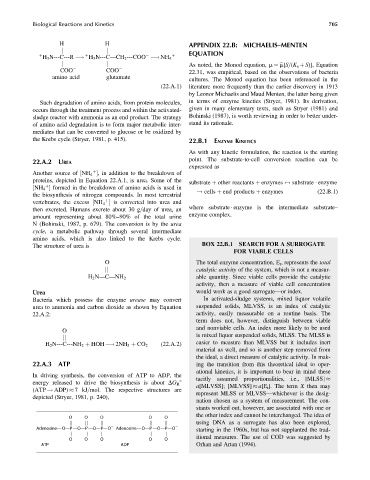Page 750 - Fundamentals of Water Treatment Unit Processes : Physical, Chemical, and Biological
P. 750
Biological Reactions and Kinetics 705
H H APPENDIX 22.B: MICHAELIS–MENTEN
EQUATION
j j
þ þ þ
H 3 N---C---R ! H 3 N---C---CH 2 ---COO ! NH 4
As noted, the Monod equation, m ¼ bm[S=(K s þ S)], Equation
j j
COO COO 22.31, was empirical, based on the observations of bacteria
amino acid glutamate
cultures. The Monod equation has been referenced in the
(22:A:1) literature more frequently than the earlier discovery in 1913
by Leonor Michaelis and Maud Menten, the latter being given
Such degradation of amino acids, from protein molecules, in terms of enzyme kinetics (Stryer, 1981). Its derivation,
occurs through the treatment process and within the activated- given in many elementary texts, such as Stryer (1981) and
sludge reactor with ammonia as an end product. The strategy Bohinski (1987), is worth reviewing in order to better under-
of amino acid degradation is to form major metabolic inter- stand its rationale.
mediates that can be converted to glucose or be oxidized by
the Krebs cycle (Stryer, 1981, p. 415). 22.B.1 ENZYME KINETICS
As with any kinetic formulation, the reaction is the starting
point. The substrate-to-cell conversion reaction can be
22.A.2 UREA
expressed as
Another source of NH 4 , in addition to the breakdown of
þ
½
proteins, depicted in Equation 22.A.1, is urea. Some of the
substrate þ other reactants þ enzymes $ substrate enzyme
NH 4 formed in the breakdown of amino acids is used in
þ
! cells þ end products þ enzymes (22:B:1)
½
the biosynthesis of nitrogen compounds. In most terrestrial
vertebrates, the excess NH 4 is converted into urea and
þ
½
then excreted. Humans excrete about 30 g=day of urea, an where substrate enzyme is the intermediate substrate–
amount representing about 80%–90% of the total urine enzyme complex.
N (Bohinski, 1987, p. 679). The conversion is by the urea
cycle, a metabolic pathway through several intermediate
amino acids, which is also linked to the Krebs cycle.
The structure of urea is BOX 22.B.1 SEARCH FOR A SURROGATE
FOR VIABLE CELLS
O The total enzyme concentration, E t , represents the total
catalytic activity of the system, which is not a measur-
k
able quantity. Since viable cells provide the catalytic
H 2 N---C---NH 2
activity, then a measure of viable cell concentration
Urea would work as a good surrogate—or index.
Bacteria which possess the enzyme urease may convert In activated-sludge systems, mixed liquor volatile
urea to ammonia and carbon dioxide as shown by Equation suspended solids, MLVSS, is an index of catalytic
22.A.2: activity, easily measurable on a routine basis. The
term does not, however, distinguish between viable
and nonviable cells. An index more likely to be used
O
is mixed liquor suspended solids, MLSS. The MLSS is
k
H 2 N---C---NH 2 þ HOH ! 2NH 3 þ CO 2 (22:A:2) easier to measure than MLVSS but it includes inert
material as well, and so is another step removed from
the ideal, a direct measure of catalytic activity. In mak-
22.A.3 ATP ing the transition from this theoretical ideal to oper-
ational kinetics, it is important to bear in mind these
In driving synthesis, the conversion of ATP to ADP, the
energy released to drive the biosynthesis is about DG R 8 tacitly assumed proportionalities, i.e., [MLSS]
a[MLVSS]; [MLVSS] a[E t ]. The term X then may
(ATP ! ADP) 7kJ=mol. The respective structures are
represent MLSS or MLVSS—whichever is the desig-
depicted (Stryer, 1981, p. 240),
nation chosen as a system of measurement. The con-
stants worked out, however, are associated with one or
the other index and cannot be interchanged. The idea of
O O O O O
using DNA as a surrogate has also been explored,
jj jj jj jj jj
Adenosine—O—P—O—P—O—P—O Adenosine—O—P—O—P—O starting in the 1960s, but has not supplanted the trad-
itional measures. The use of COD was suggested by
j j j j j
O O O O O
ATP ADP Orhan and Artan (1994).

